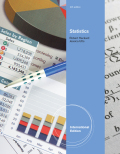
STATISTICS, 4e, International Edition emphasizes the conceptual development of statistical ideas and the importance of looking for -and finding -meaning indata. Authors Jessica Utts and Robert Heckard actively engage students' natural curiosity, motivating them with intriguing questions and explaining statistical topics in the context of a wide range of interesting, useful examples andcase studies. Throughout, the authors balance the promotion of statistical literacy with coverage of the statistical methodology taught in general introductory statistics courses. Their approach is based on the premises that new material is much easier to learn and remember if it is related to something interesting or previously known, and if students actively ask questions and find theanswers for themselves. More than any other text available, STATISTICS, 4e, International Edition motivates and encourages students to develop their statistical intuition by focusing on analyzing data and interpreting results, ratherthan on mathematical formulation. CourseSmart goes beyond traditional expectations -providing instant, online access to the textbooks and course materials you need and at a lower cost toyour students. To request an electronic sample of this Cengage Learning title, go to: www.coursesmart.com/instructors. INDICE: 1. STATISTICS SUCCESS STORIES AND CAUTIONARY TALES. What Is Statistics? Eight Statistical Stories with Morals. The Common Elements in the Eight Stories. 2. TURNING DATA INTO INFORMATION. Raw Data. Types of Variables. Summarizing One or Two Categorical Variables. Exploring Features of Quantitative Data with Pictures. Numerical Summaries of Quantitative Variables. How to HandleOutliers. Bell-Shaped Distributions and Standard Deviations. Skillbuilder Applet: The Empirical Rule in Action. 3. RELATIONSHIPS BETWEEN QUANTITATIVE VARIABLES. Looking for Patterns with Scatterplots. Describing Linear Patterns with a Regression Line. Measuring Strength and Direction with Correlation. Regression and Correlation Difficulties and Disasters. Correlation Does Not Prove Causation. Skillbuilder Applet: Exploring Correlation. 4. RELATIONSHIPS BETWEEN CATEGORICAL VARIABLES. Displaying Relationships Between Categorical Variables. Risk, Relative Risk, and Misleading Statistics About Risk. The Effect of a Third Variable and Simpson's Paradox. Assessing the Statistical Significance of a 2 x 2 Table. 5. SAMPLING: SURVEYS AND HOW TO ASK QUESTIONS. Collecting and Using Sample Data Wisely. Margin of Error, Confidence Intervals, and Sample Size.Choosing a Simple Random Sample. Other Sampling Methods. Difficulties and Disasters in Sampling. How to Ask Survey Questions. Skillbuilder Applet: Random Sampling in Action. 6. GATHERING USEFUL DATA FOR EXAMINING RELATIONSHIPS. Speaking the Language of Research Studies. Designing a Good Experiment. Designing aGood Observational Study. Difficulties and Disasters in Experiments and Observational Studies. 7. PROBABILITY. Random Circumstances. Interpretations of Probability. Probability Definitions and Relationships. Basic Rules for Finding Probabilities. Finding Complicated Probabilities. Using Simulation to Estimate Probabilities. Flawed Intuitive Judgments About Probability. 8. RANDOM VARIABLES. What Is a Random Variable? Discrete Random Variables. Expectations for Random Variables. Binomial Random Variables. Continuous Random Variables. Normal Random Variables. Approximating Binomial Distribution Probabilities. Sums, Differences, and Combinations of Random Variables. 9. UNDERSTANDING SAMPLING DISTRIBUTIONS: STATISTICS AS RANDOM VARIABLES. Parameters, Statistics, and Statistical Inference. From Curiosity to Questions About Parameters. SD Module 0: An Overview of Sampling Distributions. SD Module 1: Sampling Distribution for OneSample Proportion. SD Module 2: Sampling Distribution for the Difference in Two Sample Proportions. SD Module 3: Sampling Distribution for One Sample Mean.SD Module 4: Sampling Distribution for the Sample Mean of Paired Differences.SD Module 5: Sampling Distribution for the Difference in Two Sample Means. Preparing for Statistical Inference: Standardized Statistics. Generalizations Beyond the Big Five. Skillbuilder Applet: Finding the Pattern in Sample Means. 10. ESTIMATING PROPORTIONS WITH CONFIDENCE. CI Module 0: An Overview of Confidence Intervals. CI Module 1: Confidence Interval for a Population Proportion. CI Module 2: Confidence Intervals for the Difference in Two Population Proportions. Using Confidence Intervals to Guide Decisions. 11. ESTIMATING MEANS WITH CONFIDENCE. Introduction to Confidence Intervals for Means. CI Module 3: Confidence Interval for One Population Mean. CI Module 4: Confidence Interval for the Population Mean of Paired Differences. CI Module 5: Confidence Interval forthe Difference in Two Population Means (Independent Samples). Understanding Any Confidence Interval. Skillbuilder Applet: The Confidence Level in Action. 12. TESTING HYPOTHESES ABOUT PROPORTIONS. HT Module 0: An Overview of Hypothesis Testing. HT Module 1: Testing Hypotheses About a Population Proportion. HT Module 2: Testing Hypotheses About the Difference in Two Population Proportions. Sample Size, Statistical Significance, and Practical Importance. 13. TESTINGHYPOTHESES ABOUT MEANS. Introduction to Hypothesis Tests for Means. HT Module3: Testing Hypotheses about One Population Mean. HT Module 4: Testing Hypotheses about the Population Mean of Paired Differences. HT Module 5: Testing Hypotheses about the Difference in Two Population Means (Independent Samples). TheRelationship Between Significance Tests and Confidence Intervals. Choosing anAppropriate Inference Procedure. Effect Size. Evaluating Significance in Research Reports. 14. INFERENCE ABOUT SIMPLE REGRESSION. Sample and Population Regression Models. Estimating the Standard Deviation for Regression. Inference About the Slope of a Linear Regression. Predicting y and Estimating Mean y at a Specific x. Checking Conditions for Using Regression Models for Inference. 15.MORE ABOUT INFERENCE FOR CATEGORICAL VARIABLES. The Chi-Square Test for Two-Way Tables. Analyzing 2 x 2 Tables. Testing Hypotheses About One Categorical Variable: Goodness-of-Fit. 16. ANALYSIS OF VARIANCE. Comparing Means with an ANOVA F-Test. Details of One-Way Analysis of Variance. Other Methods for Comparing Populations. Two-Way Analysis of Variance. 17. TURNING INFORMATION INTO WISDOM. Beyond the Data. Transforming Uncertainty Into Wisdom. Making Personal Decisions. Control of Societal Risks. Understanding Our World. Getting to Know You. Words to the Wise.
- ISBN: 978-0-538-73591-9
- Editorial: Brooks/Cole
- Encuadernacion: Rústica
- Páginas: 800
- Fecha Publicación: 11/03/2011
- Nº Volúmenes: 1
- Idioma: Inglés
